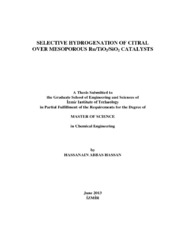Please use this identifier to cite or link to this item:
https://hdl.handle.net/11147/3574Full metadata record
| DC Field | Value | Language |
|---|---|---|
| dc.contributor.advisor | Yılmaz, Selahattin | en |
| dc.contributor.author | Hassan, Hassanain Abbas | - |
| dc.date.accessioned | 2014-07-22T13:51:50Z | - |
| dc.date.available | 2014-07-22T13:51:50Z | - |
| dc.date.issued | 2013 | en |
| dc.identifier.uri | http://hdl.handle.net/11147/3574 | - |
| dc.description | Thesis (Master)--Izmir Institute of Technology, Chemical Engineering, Izmir, 2013 | en |
| dc.description | Includes bibliographical references (leaves: 68-72) | en |
| dc.description | Text in English; Abstract: Turkish and English | en |
| dc.description | xiii, 84 leaves | en |
| dc.description.abstract | The liquid phase citral hydrogenation was investigated over Ru/SiO2, Ru/TiO2 and Ru/TiO2/SiO2 catalysts. TiO2/SiO2 supports were prepared by sol-gel deposition, impregnation and absorption methods. The effect of the supports and catalyst reduction temperature, 300 ï‚°C (LTR) and 450 ï‚°C (HTR) on citral conversion and selectivity to unsaturated alcohols were examined. A well-defined crystalline anatase phase was only observed on the support prepared by absorption method, TiO2/SiO2-ABS. A high dispersion and interaction of Ru were observed over TiO2 for Ru/TiO2. Ru/TiO2/SiO2-ABS also displayed similar properties but to a lower extent. Ru/TiO2/SiO2-ABS catalyst showed the highest citral conversion (57.7 %) at LTR among the different Ru/TiO2/SiO2 catalysts. Its selectivity to UA was also high (70.2 %). This was attributed to a better metal support interaction and dispersion obtained by this method. However, a selectivity of 62.6 % was obtained over Ru/TiO2. Activity of the catalysts was mostly observed to decrease as reduction temperature increased from 300 ï‚°C to 450 ï‚°C. Citral conversion decreased from 57.7 % to 42.3 % over Ru/TiO2/SiO2-ABS. However, selectivities to unsaturated alcohol (nerol and geraniol) over Ru/TiO2 and Ru/TiO2/SiO2 catalysts were increased at HTR, reaching about 80 %. This was suggested to be due to more interaction of TiO2 with the Ru (strong metal support interaction). There was no significant change in the selectivity to UA obtained at HTR for Ru/SiO2. This was related to the inert nature of SiO2. | en |
| dc.language.iso | en | en_US |
| dc.publisher | Izmir Institute of Technology | en |
| dc.rights | info:eu-repo/semantics/openAccess | en_US |
| dc.subject.lcsh | Citrates | en |
| dc.subject.lcsh | Hydrogenation | en |
| dc.subject.lcsh | Mesoporous materials | en |
| dc.subject.lcsh | Catalysts | en |
| dc.title | Selective hydrogenation of citral over mesoporous Ru/TiO2/SiO2 catalysts | en_US |
| dc.type | Master Thesis | en_US |
| dc.institutionauthor | Hassan, Hassanain Abbas | - |
| dc.department | Thesis (Master)--İzmir Institute of Technology, Chemical Engineering | en_US |
| dc.relation.publicationcategory | Tez | en_US |
| item.grantfulltext | open | - |
| item.openairecristype | http://purl.org/coar/resource_type/c_18cf | - |
| item.cerifentitytype | Publications | - |
| item.openairetype | Master Thesis | - |
| item.languageiso639-1 | en | - |
| item.fulltext | With Fulltext | - |
| Appears in Collections: | Master Degree / Yüksek Lisans Tezleri | |
Files in This Item:
| File | Description | Size | Format | |
|---|---|---|---|---|
| T001107.pdf | MasterThesis | 3.62 MB | Adobe PDF |  View/Open |
CORE Recommender
Page view(s)
80
checked on Apr 22, 2024
Download(s)
92
checked on Apr 22, 2024
Google ScholarTM
Check
Items in GCRIS Repository are protected by copyright, with all rights reserved, unless otherwise indicated.